National Hunt Racing, also known as Jump Racing, is a form of Horse Racing particular to France, Great Britain and Ireland that requires Horses to jump over fences and ditches.
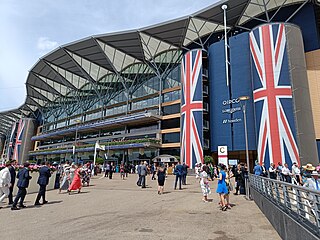
Ascot Racecourse is a dual-purpose British racecourse, located in Ascot, Berkshire, England, about 25 miles west of London. Ascot is used for thoroughbred horse racing, and it hosts 13 of Britain's 36 annual Flat Group 1 horse races and three Grade 1 Jumps races. The current racetrack's grandstand was completed in 2006.

Aintree Racecourse is a racecourse in Aintree, Metropolitan Borough of Sefton, Merseyside, England, bordering the city of Liverpool. The racecourse is the venue for the Grand National steeplechase, which takes place annually in April over three days. Aintree also holds meetings in May, October (Sunday), November and December.

Royal Randwick Racecourse is a racecourse for horse racing located in the Eastern Suburbs of Sydney, New South Wales. Randwick Racecourse is Crown Land leased to the Australian Turf Club and known to many Sydney racegoers as headquarters. The racecourse is located about six kilometres south-east from the Sydney Central Business District in the suburb of Randwick. The course proper has a circumference of 2224m with a home straight of 410m.

Leicester Racecourse is a horse racing course in Oadby, Leicestershire, about three miles south of the city centre.

Cheltenham Racecourse at Prestbury Park, near Cheltenham, Gloucestershire, England, hosts National Hunt horse racing. Racing at Cheltenham took place in 1815, but comprised only minor flat races on Nottingham Hill. The first racing on Cleeve Hill was on Tuesday 25 August 1818 when the opening race was won by Miss Tidmarsh, owned by Mr E Jones. It was a year later when the results were printed in the Racing Calendar when a programme of flat racing was watched by the Duke of Gloucester who donated 100 Guineas to the prize fund. By 1831 races were being staged at Prestbury, although not on the present day course. In 1834 the Grand Annual Steeplechase was run for the first time. In 1839 Lottery won the Grand Annual having previously won the first Aintree Grand National. In 1840 the meeting transferred to Andoversford for a brief period, only to return to Prestbury in 1847. 1902 was a notable year in that racing moved to the present course at Prestbury Park. The new stands were completed in 1914 and the present day Festival races, as we know them, began to take shape. The Cheltenham Gold Cup, over 3 ¼ miles, was run for the first time in 1924, with the Champion Hurdle following in 1927.
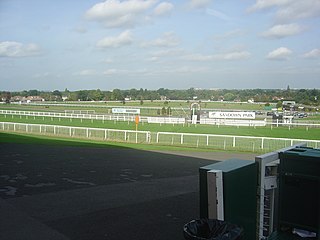
Sandown Park is a horse racing course and leisure venue in Esher, Surrey, England, located in the outer suburbs of London. It hosts 5 Grade One National Hunt races and one Group 1 flat race, the Eclipse Stakes. It regularly has horse racing during afternoons, evenings and on weekends, and also hosts many non-racing events such as trade shows, wedding fairs, toy fairs, car shows and auctions, property shows, concerts, and even some private events. It was requisitioned by the War Department from 1940-1945 for World War II. The venue has hosted bands such as UB40, Madness, Girls Aloud, Spandau Ballet and Simply Red. The racecourse is close to Esher railway station, served by trains from London Waterloo. There is a secondary exit from Esher station which is open on race days, this exit leads directly into the racecourse and Lower Green, Esher.
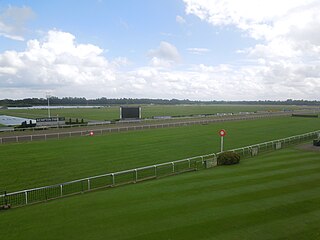
Kempton Park Racecourse is a horse racing track together with a licensed entertainment and conference venue in Sunbury-on-Thames, Surrey, England, on the border with Greater London; it is 13 miles west of Charing Cross in central London. The site has 210 acres of flat grassland surrounded by woodland with two lakes in its centre. Its entrance borders Kempton Park railway station which was created for racegoers on a branch line from London Waterloo, via Clapham Junction.

Ayr Racecourse at Whitletts Road, Ayr, Scotland, was opened in 1907. There are courses for flat and for National Hunt racing.

A point-to-point is a form of horse racing over fences for hunting horses and amateur riders. In Ireland, where the sport is open to licensed professional trainers, many of the horses will appear in these races before they compete in National Hunt races. Consequently, the Irish point-to-point tends to be used as a nursery for future young stars: a horse that wins its debut point-to-point in Ireland will often sell for a high price. Whilst professional trainers are specifically excluded from running horses in point-to-points in Great Britain, the days of the farmer running his hunter at the local point-to-point are gone.. Increasingly, horses are run from "livery yards" - unlicensed but otherwise professional training establishments, sometimes closely allied with a licensed yard.

The Queen Mother Champion Chase is a Grade 1 National Hunt steeplechase in Great Britain which is open to horses aged five years or older. As part of a sponsorship agreement with the online betting company Betway, the race is now known as the Betway Queen Mother Champion Chase. It is run on the Old Course at Cheltenham over a distance of about 2 miles, and during its running there are thirteen fences to be jumped. The race is scheduled to take place each year during the Cheltenham Festival in March.
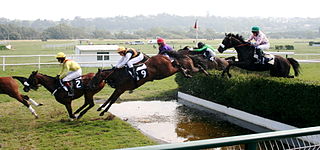
A steeplechase is a distance horse race in which competitors are required to jump diverse fence and ditch obstacles. Steeplechasing is primarily conducted in Ireland, Great Britain, Canada, United States, Australia, and France. The name is derived from early races in which orientation of the course was by reference to a church steeple, jumping fences and ditches and generally traversing the many intervening obstacles in the countryside.
Henrietta Catherine Knight is an English Thoroughbred racehorse trainer. Knight is best known as a trainer of National Hunt racehorses.

Cartmel Racecourse is a small national hunt racecourse in the village of Cartmel, now in the ceremonial county of Cumbria, historically in Lancashire. Until 1969, the two day Whitsun meeting was Cartmel's only fixture, when an August Bank Holiday Monday meeting was introduced. In 1974 a Saturday programme was added to the new meeting, making a total of four days' racing.

Kelso Racecourse is a thoroughbred horse racing venue located in Kelso, Scotland. It is frequently described as "Britain's Friendliest Racecourse". It was voted the Best Small Course in Scotland and the North of England in 2007, 2012 and 2014 by the Racegoers Club. In addition to staging Scotland's most valuable hurdle race, the Morebattle Hurdle, Kelso stages a comparatively high number of Class 1, 2 & 3 races over jumps.
The 1838 Grand Liverpool Steeplechase was the last of three unofficial annual precursors of a Handicap Steeple-chase, later to become known as the Grand National Steeplechase horse race which took place at Aintree Racecourse near Liverpool on Monday 5 March 1838 and attracted a field of only three runners. This race did not carry the prestige of the future Grand Nationals and its status as an official Grand National was revoked sometime between 1862 and 1873.
The Peterborough Chase is a Grade 2 National Hunt chase in Great Britain which is open to horses aged four years or older. It is run at Huntingdon over a distance of about 2 miles and 4 furlongs, and during its running there are sixteen fences to be jumped. The race is currently scheduled in December. In 2019, the race's total prize fund was £65,000.
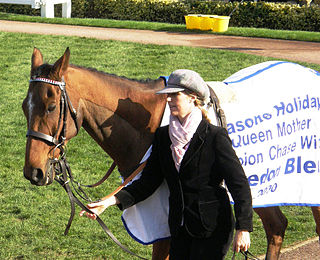
Edredon Bleu was an AQPS National Hunt racehorse. He was bred in France but trained for most of his racing career in the United Kingdom. He was a specialist steeplechaser who recorded most of his wins over two and two-and-a-half miles, but was capable of winning major races over longer distances. In a ten-year racing career he ran fifty-seven times and won twenty-five races. His most important successes when winning the Queen Mother Champion Chase in 2000 and the King George VI Chase in 2003.
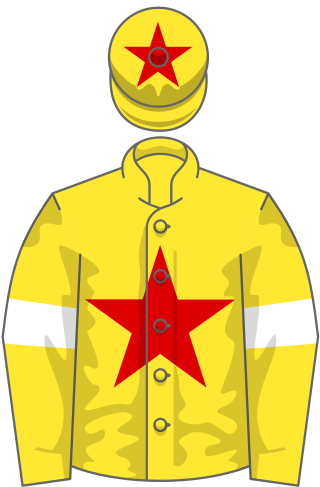
One Man was an Irish-bred National Hunt steeplechase racehorse sired by Remainder Man out of the mare Steal On. The popular grey won 20 of 35 races, including the Queen Mother Champion Chase in 1998. He was trained by the late Gordon W. Richards and owned by John Hales. Renowned for his jumping ability and high cruising speed, he was nicknamed his "little bouncing ball" by Richards and was adopted by many as the new Desert Orchid. One Man received a Timeform rating of 179, an outstanding figure.
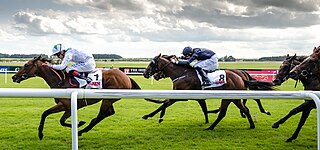
Horse racing in Ireland is intricately linked with Irish culture and society. The racing of horses has a long history on the island, being mentioned in some of the earliest texts. Domestically, racing is one of Ireland's most popular spectator sports, while on the international scene, Ireland is one of the strongest producers and trainers of Thoroughbred horses. The Irish horse racing industry is closely linked with that of Great Britain, with Irish horses regularly competing and winning on the British racing circuit.


















